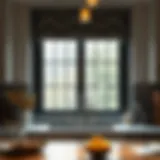Foldable Partitions: Versatile Solutions for Modern Interiors
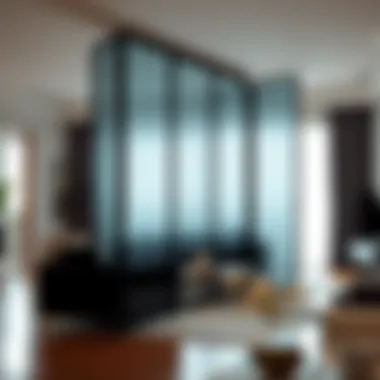
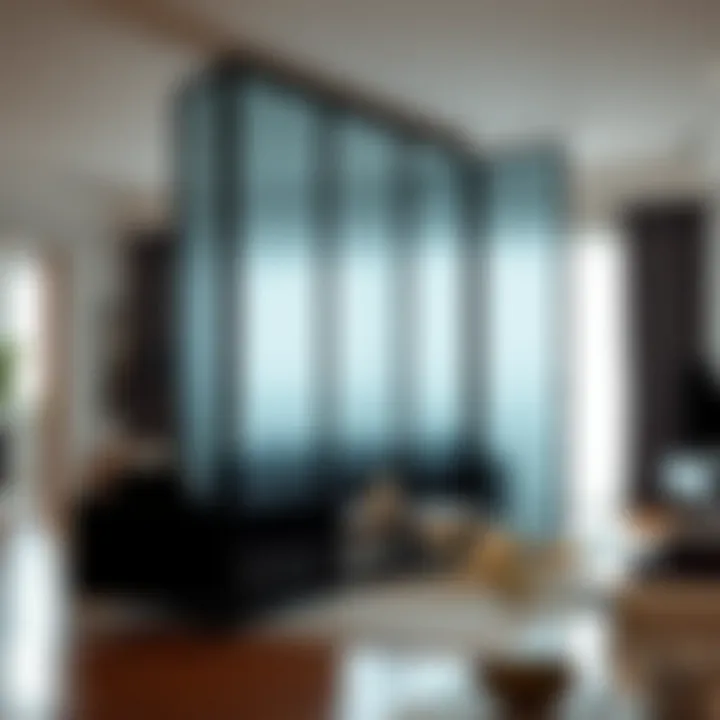
Intro
The world of interior design is undergoing constant transformation, influenced by advancements in materials and changing lifestyles. One notable trend that has emerged is the use of foldable partitions. They are not just mere dividers; they embody versatility and creativity, enabling spaces to adapt to the needs of the moment. In this discussion, we will explore the intricate details surrounding foldable partitions, their materials, various applications, and how they significantly contribute to modern interior aesthetics.
By embracing these movable elements, homeowners and designers can enhance the functionality and appeal of their spaces, whether in homes, offices, or creative studios. So, let’s jump right in and discover how adaptable these structures can be!
Furniture Trends and Styles
Current Trends in Furniture Design
In the realm of interior furnishings, rethinking the conventional is key. Contemporary designs lean toward multi-functional pieces that serve several purposes. Foldable partitions are right in the thick of this shift. They allow for flexibility, enabling rooms to adjust based on need—a seamless transition from an open layout for entertaining guests to a more intimate setting when privacy is required.
Another trend that is striding ahead is the use of sustainable materials. People are conscious of their choices now more than ever, preferring raw and eco-friendly materials in furniture design. For instance, bamboo and reclaimed wood serve as excellent choices for foldable partitions, marrying style with ethics.
Popular Furniture Styles and Their Characteristics
From mid-century modern with its clean lines to bohemian styles filled with intricate patterns, furniture styles vary widely. Here’s a quick overview of how foldable partitions can fit into popular design categories:
- Minimalist: Characterized by simplicity and function, folds away easily as part of the clean aesthetic.
- Industrial: Raw materials like metal and wood can accentuate the rugged feel while providing structural efficacy.
- Scandinavian: Light-colored woods and soft tones can be incorporated seamlessly to create bright, cheerful spaces.
- Traditional: Elegant designs in hinged options can provide a classic touch without sacrificing flexibility.
In each style, foldable partitions do more than just divide; they enhance the look and function of a space.
Buying and Maintenance Guides
Essential Tips for Purchasing Furniture
When considering foldable partitions, it’s good to keep a few pointers in mind. Look at dimensions, weight, and material. A well-measured space means a partition will fit without overcrowding the area. Lightweight materials allow for easy movement, which is essential for adjustable designs. Lastly, check the durability—this is vital if you expect to use the partition regularly.
Maintenance and Care for Different Furniture Materials
Once you have made your purchase, maintaining your foldable partition appropriately can prolong its life and keep it looking sharp. Here’s how to care for common materials:
- Wood: Regular dusting and occasional polishing with natural oils can keep the finish intact.
- Fabric: Opt for stain-repellent fabrics and give them a gentle vacuum every so often.
- Metal: Any rust or wear should be addressed promptly; a damp cloth works wonders here.
By understanding the nuances of materials and care, you can ensure that your partition remains a stunning feature in your home for years to come.
“Foldable partitions are more than just a physical divider; they're a creative solution for dynamic living spaces.”
In essence, foldable partitions, with their myriad of designs and applications, hold the power to reshape contemporary interiors. As we venture further into this topic, we will delve deeper into specific designs, installation methods, and unique uses that showcase their boundless potential. For additional information, feel free to explore resources on platforms like Wikipedia, as well as design blogs and forums like Facebook and Reddit.
\n
Understanding Foldable Partitions
Foldable partitions have gained significant traction in modern interior design, serving both aesthetic and functional preferences. Their importance lies not just in dividing spaces, but also in offering flexibility, adaptability, and style to residential and commercial environments. These installations empower homeowners and designers alike to address the myriad challenges posed by ever-changing lifestyle demands, transforming spaces at a moment's notice.
Definition and Purpose
Foldable partitions, as the name suggests, are movable walls that can be folded or collapsed to create distinct areas within a larger room. Unlike traditional walls, which are permanent structures, foldable partitions provide a means to adapt the spatial layout without the permanence or expense of renovation. Their main purpose is to enhance functionality by allowing the multifunctionality of spaces. For instance, a living room can morph into an office area or a dining space more easily when using these partitions.
Some key benefits of foldable partitions include:
- Versatility: They can be utilized in diverse environments such as homes, offices, and cafes.
- Aesthetic Appeal: With a variety of materials and finishes, they can complement or enhance existing decor.
- Space Optimization: They help in maximizing the utility of smaller spaces by allowing for efficient segmentation as needed.
This adaptability makes them prized possessions in any design arsenal, catering especially to those who cherish flexibility in their living or working environments.
Historical Context
The evolution of foldable partitions is as layered as the design trends they now reflect. Their origins can be traced back to ancient civilizations. In Japan, for example, shoji screens were used as early as the 7th century to divide rooms while allowing light to penetrate the space. These wooden frames, often fitted with translucent paper, not only exemplified functional design but became a celebrated art form.
As we moved through the centuries, different cultures adopted similar concepts but with their unique twists. In Victorian England, intricately designed screens adorned with ornate details became fashionable within parlors, adding both privacy and charm. Fast forward to the 20th century, and we see a surge in minimalist designs, reflecting the modernist movement's emphasis on functionality and simplicity.
Today, foldable partitions have evolved to encapsulate a range of styles and materials, including contemporary designs that utilize glass and metal, intricate wooden constructions, and innovative fabric solutions. Their continued evolution illustrates an adaptability to modern needs while maintaining the essence of their historical roots.
"Foldable partitions are not merely functional additions to a space; they are elements that tell a story of design evolution and cultural significance."
Types of Foldable Partitions
When it comes to maximizing the potential of modern interiors, understanding the types of foldable partitions is crucial. Each type serves specific needs and presents unique benefits, making them a favored choice for homeowners and designers alike. The right selection can not only enhance functionality but also contribute to the overall aesthetic appeal of a space. Here’s a closer look at three prominent types of foldable partitions, each with its own footprint in the world of interior design.
Bi-Fold Partitions
Bi-fold partitions are primarily known for their ability to seamlessly transform spaces. They consist of panels that fold against each other, creating an elegant division between rooms or areas. This type is particularly popular in homes with open floor plans, allowing for flexibility without compromising on light and flow. Installing bi-fold partitions can foster the creation of distinct environments where different activities can coalesce yet remain separate.
One of the compelling aspects of bi-fold partitions is their versatility. Homeowners can customize them in terms of material, color, and finish to harmonize with their existing decor. Additionally, they can be easily opened to connect spaces during gatherings, making them a practical solution for the social butterfly. Some key points include:
- Space Efficiency: They require minimal room to operate, making them suitable for tighter areas.
- Aesthetic Appeal: Can be designed to reflect personal style, from sleek modern lines to rustic wooden finishes.
- Accessibility: Easier to manipulate than traditional doors, offering hassle-free transitions between spaces.
"Keeping your home dynamic means ensuring that transitions between different spaces can happen without a hitch. Bi-fold partitions do just that!"
Accordion Partitions
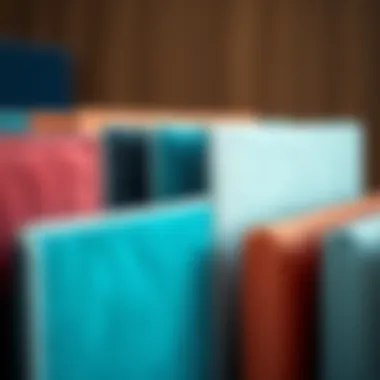
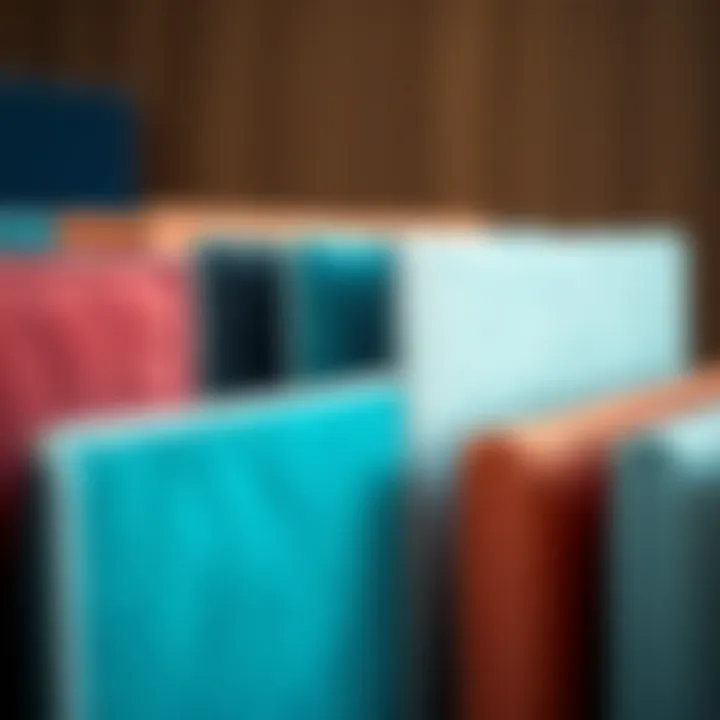
Then we have accordion partitions, which are essentially the charming cousins of bi-fold designs. Named for their unique folding mechanism that resembles the bellows of an accordion, these partitions are a fantastic choice for areas that experience frequent reconfiguration, such as large living rooms or conference spaces.
Their flexibility is unmatched. When fully opened, accordion partitions can retract to occupy a small area, allowing expansive access to wider spaces. This flexibility makes them ideal for multifunctional rooms where the purpose may change throughout the day. Consider the following benefits:
- Budget-Friendly: Often available at a lower price point than other partition types, appealing to cost-conscious individuals.
- Acoustic Benefits: Many accordion partitions come with sound-insulation capabilities, providing privacy without sacrificing sound quality.
- Quick Installation: Generally simple to install, not requiring extensive tools or professional assistance.
Sliding Partitions
Sliding partitions offer a modern take on space division. They operate along tracks and glide open or closed, making them an appealing option for contemporary interior settings. Unlike their folding counterparts, which require physical space to fold away, sliding partitions move horizontally, providing a seamless solution when space is at a premium.
This type of partition can be very striking, featuring glass panels or heavy woods that create visual interest. Here are some notable advantages:
- Stylish and Modern: They can create dramatic statements, especially when using high-quality materials like frosted glass or polished wood.
- Space-Saving Design: Ideal for smaller spaces, as they don’t protrude into the room when open.
- Enhanced Light Flow: Glass options can help maintain natural light while still providing separation, creating an airy feel in spaces.
When designed thoughtfully, each type of foldable partition can elevate interior spaces, enhancing both functionality and aesthetics. The selection of the right type will largely depend on individual needs and preferences, along with the particular dynamics of the space.
Materials Used in Foldable Partitions
Understanding the materials used in foldable partitions is key to grasping their overall impact on modern interiors. The choice of material not only affects the aesthetic appearance of the space but also determines its functionality, durability, and maintenance requirements. Homeowners and designers alike must weigh these factors carefully to find the right balance between style and utility.
Choosing a material that complements existing decor can unify the space, making it feel more holistic. Proper selection of materials can also maximize the partition’s flexibility in transforming an area, adapting to different needs as they arise. Below, we will delve deeper into three prominent materials used for foldable partitions: wood, glass and acrylic, and fabric and canvas.
Wood Enclosed Designs
Wood has always been a staple in interior design, renowned for its warmth and natural beauty. When it comes to foldable partitions, wood offers a versatile option that can vary from sleek modern finishes to traditional rustic styles. Here are a few considerations:
- Aesthetic Appeal: Wood partitions lend a cozy feel to spaces, turning an empty area into a welcoming one. They can be painted or stained to match any decor.
- Durability: Well-crafted wood partitions can stand the test of time. They don't easily succumb to wear and tear, giving them a longer lifespan compared to some other materials.
- Insulation Properties: Wood also provides better sound insulation than many alternatives, which could make it ideal for spaces needing privacy.
However, it’s important to consider that wood requires regular maintenance; frequent polishing maybe needed to combat weather changes that may cause the material to warp.
Glass and Acrylic Innovations
In contrast to wood, glass and acrylic partitions present a modern and clean aesthetic. These materials are often utilized in work environments or urban homes to create open-feeling spaces without sacrificing functionality. Here’s what makes them noteworthy:
- Transparency and Light: One of the most significant advantages is how these materials allow natural light to flow through a space. They give the illusion of a larger area, making them perfect for compact homes.
- Easy to Clean: Maintenance is relatively straightforward since most glass and acrylic surfaces can simply be wiped down.
- Variety of Finishes: With options ranging from frosted to textured glass, the versatility in style can cater to a range of design goals, whether it’s modern chic or industrial.
On the downside, glass can be quite heavy and fragile, which might present challenges during installation. That said, advancements in tempered glass technology have addressed many concerns surrounding durability.
Fabric and Canvas Options
Fabric and canvas partitions are an innovative and flexible choice that cater particularly well to temporary or multifunctional spaces. They often provide a softer contrast to harder materials like wood or glass. Consider some key points:
- Flexibility: Fabric partitions can be used to create ephemeral spaces that can be easily reconfigured. This feature is especially useful in environments where needs change frequently, like event spaces or studios.
- Variety: With a plethora of fabric types, colors, and patterns available, it’s easy to customize these partitions to project any desired mood or theme.
- Cost-Effective: Generally, these partitions can be more economical than their wood or glass counterparts, making them a favorite amongst DIYers and budget-conscious homeowners.
However, fabric is more susceptible to dirt and damage, requiring regular cleaning and care to maintain their appearance.
As we explore the materials used in foldable partitions, it becomes clear that each option brings its own set of benefits and drawbacks. The ideal material often hinges on specific needs and preferences.
By understanding the characteristics of these materials, homeowners and designers can make informed choices that enhance both the function and design of their interiors. As the popularity of foldable partitions continues to grow, the thoughtful selection of materials will remain pivotal in creating adaptable and aesthetically pleasing spaces.
Applications of Foldable Partitions in Home Design
Foldable partitions have become a key player in contemporary home design, offering a variety of applications that enhance both aesthetics and functionality. They are not just borders between rooms; they allow for dynamic space organization, which is especially important in our bustling lives. By deploying these partitions thoughtfully, homeowners, designers, and decorators can create environments that are tailored to their exact needs without needing a complete overhaul of the interior.
Creating Distinct Spaces
Foldable partitions serve the vital purpose of delineating areas within a larger space, providing a sense of structure while maintaining flow. Think about those cozy evening dinners or a family get-together. In such scenarios, you may want a dining area that feels separate yet connected to the living space. A bi-fold partition could neatly transform a vast room into distinct areas, allowing for varied activities without feeling confined.
Additionally, the visual impact cannot be emphasized enough. A well-chosen partition can become a centerpiece that complements the overall design of the room. By selecting materials and colors that align with existing decor, the partition doesn’t just divide; it enhances the aesthetic quality of the space.
Enhancing Privacy in Open Layouts
Open floor plans are adored for their airy feel but oftentimes they fall short when it comes to privacy. This is where foldable partitions step in like superheroes of home design. Imagine a scenario where a couple is hosting guests, but one partner is working from home in the same space. A temporary partition can be set up to create a private nook for the home office, offering both privacy and peace of mind without the commitment of permanent walls.
Such partitions also have another benefit: sound reduction. Some materials act as sound barriers, which further aids in creating a more serene environment. As the saying goes, “Good fences make good neighbors”—and in this case, the right partition provides not just a physical boundary but also an auditory one.
Temporary Solutions for Multifunctional Areas
In the world of modern living, multifunctional spaces are all the rage. With fewer people residing in larger homes, we are often tasked with maximizing the use of each area. For instance, a room that serves as a guest bedroom during the holidays can also function as a playroom for kids or a home office at different times of the year.
Foldable partitions offer a handy solution for such scenarios, allowing for easy reconfiguration of the space. On a quiet weekday, you may need that space to be a functional office, while on weekends, it could magically transform into a cozy guest suite. With just a flick of the wrist, you can alter the look and purpose of a room, creating not just functionality but also a sense of excitement and adaptability in your home.
"Foldable partitions are not just about space management; they are about creating an experience that adapts to life’s rhythms."
Given these applications, it becomes clear that foldable partitions hold significant value in home design. They cater to the evolving needs of modern living, enhancing aesthetic appeal while simultaneously serving practical functions. Whether it’s about creating distinct spaces, adding a level of privacy in open layouts, or offering temporary solutions for multifunctional areas, these partitions are indeed versatile tools in the designer's toolkit.
Design Considerations for Foldable Partitions
When it comes to foldable partitions, there's quite a bit to chew on in terms of design. These partitions are not just physical barriers; they play a crucial role in how spaces feel and function. Homeowners and designers alike must pay attention to several key elements to ensure these installations enhance rather than hinder the overall aesthetic. A beautifully designed foldable partition can tie a room together, create harmony, and bring out the best in existing decor while providing flexibility in usage.
Aesthetic Cohesion with Existing Decor
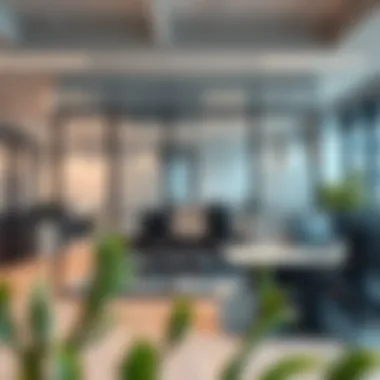
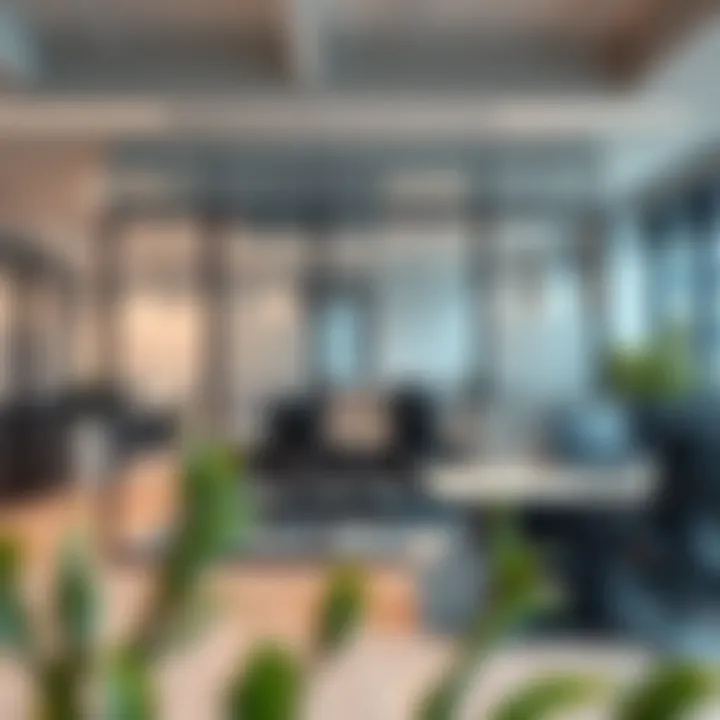
Creating harmony between a foldable partition and the existing design of a space is essential. A partition should feel like a natural extension of the room rather than an afterthought. To achieve this aesthetic cohesion, consider the following:
- Material Matching: It helps to select materials that resonate with the existing textures in the room. If the decor emphasizes wood tones, opting for a wooden partition helps maintain that warmth. In contrast, if glass is prevalent in the environment, a transparent partition will ensure continuity.
- Style Consistency: Modern apartments may benefit from sleek, minimalistic designs, whereas vintage homes might better suit ornate patterns. Align the partition's style with the overall theme of the house to keep the flow consistent.
- Functional Fit: Beyond appearance, it’s vital to ensure that the partition serves a practical purpose that complements the room’s layout. For example, a foldable partition that divides a living area and dining room could also incorporate shelving, which not only divides space but enhances functionality and visual interest.
The right partition can echo the spirit of the decor, creating a seamless visual bond that is both pleasing and functional.
Maximizing Natural Light
Natural light plays a fundamental role in the perception of space. A carefully chosen foldable partition can work wonders in maximizing light exposure while maintaining the needed privacy. Here are some ways to optimize light:
- Transparent Elements: Consider glass or acrylic designs that allow light to filter through while creating physical boundaries. Frosted glass can provide privacy without completely blocking light, making it an ideal choice for home offices or meditation spaces.
- Strategic Placement: Position partitions in such a way that they do not obstruct existing light sources, like windows. Sliding partitions can be designed to glide open past windows, ensuring unobstructed views that enhance natural lighting.
- Reflection: Utilize materials that reflect light, like shiny finishes or light colors, to enhance the brightness of a room. Light-hued wood or mirrors as part of a partition can help bounce light around, making spaces feel larger and more open.
Taking these factors into account can open up a space in a magical way, allowing natural light to flow freely and fill every corner.
Color and Finish Selection
Choosing the right colors and finishes for a foldable partition can dictate the mood and style of a room. Colors can evoke emotions and influence how a space is perceived. Here are some considerations when selecting:
- Color Dynamics: Stick to a palette that is already established in the room. While bold statements can work, they sometimes clash with more subdued color schemes. If the room has a lot of earthy tones, a deep green or warm beige for the partition could harmonize beautifully.
- Finish Variance: Different finishes—matte, glossy, textured—can dramatically alter a partition's appearance. A glossy finish can add a modern touch, while a matte look can give a softer, more inviting feel. Texture can also add depth; consider a partition with a slight relief or pattern to catch the eye.
- Durability and Maintenance: Finally, consider how the finish will stand up over time. Materials like high-pressure laminates are low-maintenance and can resist wear and tear, making them ideal for high-traffic areas.
Effective color and finish choices can make a partition not just a divider but a conversation starter, turning a functional element into a striking focal point within the design.
Installation Process of Foldable Partitions
The installation of foldable partitions represents a vital component in maximizing the utility and flexibility of modern interiors. A well-executed installation can transform a single-dimension space into a multi-functional haven, catering to various activities and privacy needs. If done right, these partitions enhance not only the aesthetics of a room but also its functionality. However, this process can seem daunting if one is not prepared. Thus, understanding the installations basics, from initial preparation to final execution, is essential for homeowners, designers, and DIY enthusiasts alike.
Preparation and Measurements
Before embarking on the installation, proper planning cannot be overstated. Accurate measurements are the cornerstone of a successful folding partition project. Here’s what to keep in mind:
- Assess the Space: Begin by evaluating the area where the partition will be placed. Identify any obstructions such as windows, doors, and furniture. Knowing these will help you choose the right type of partition.
- Measure Twice, Cut Once: It's an old saying but rings true. Use a measuring tape to determine the height and width of the intended installation area. Note these down precisely, as even small errors can lead to complications later. A miscalculation could result in gaps or improperly fitting panels.
- Determine Functionality: Decide how you want the space to function. Will it be a permanent division, or do you need it to slide away seamlessly? This decision will influence your choice of partition.
Successful installation relies on solid groundwork, so approach this stage methodically.
Tools and Materials Required
Gathering the right tools and materials beforehand can save time and prevent headaches during installation. Consider stocking up on the following essentials:
- Tools:
- Materials:
- Drill and drill bits. Use these for affixing hinges and any mounting hardware.
- Level to ensure that your partition hangs straight.
- Screwdriver and other basic hand tools for assembly and adjustments.
- Measuring tape again, for during installation adjustments.
- The chosen type of foldable partition, whether it be bi-fold, accordion, or sliding.
- Mounting brackets appropriate for the weight and style of the partition.
- Screws that match the mounting system you are using.
- Additional trim or finish materials if blending the partition with the décor.
Having all the necessary tools and materials at your fingertips can ease the installation process, making it a more fluid experience.
Execution of Installation
With preparation complete and your tools in place, it’s time to roll up your sleeves and get to work. Here’s a step-by-step guide:
- Mark Your Position: Using a pencil, outline where the partition will be installed, ensuring it aligns with your previous measurements.
- Install the Top Track: If your partition type requires a track system (common in sliding partitions), begin with the top track. Level it carefully according to the marked outline before securing it with screws.
- Attach the Panels: Slide the panels (for bi-fold or accordion types) onto the track. For sliding panels, ensure they are properly seated in the track before proceeding.
- Secure the Bottom Track: If applicable, add the bottom track or hinge assembly. This is crucial for stability, especially in high traffic areas.
- Check Alignment and Functionality: Once everything is in place, open and close your partition several times to ensure it runs smoothly. Make any adjustments needed for alignment or function.
Tip: Adding a bit of silicone lubricant to sliding mechanisms can enhance their performance and longevity.
Proper installation is not just about putting together parts but ensuring they work harmoniously together. Having detailed knowledge of the process can empower you to create spaces that are both beautiful and practical.
Cost Considerations for Foldable Partitions
When it comes to integrating foldable partitions into modern interiors, understanding the cost implications is essential. It’s not merely about the price tag; it’s about evaluating long-term value, functionality, and how these partitions can enhance your space while keeping your budget intact. Homeowners, designers, and DIY enthusiasts must take a holistic view of costs that encompasses not just the initial purchase but also installation, maintenance, and potential alterations. With this foundation, you'll be better equipped to make savvy decisions that align with both your aesthetic desires and practical needs.
Price Range by Material Type
Different materials come with varying costs, each offering distinct advantages and styles. Here’s a concise breakdown of typical price ranges:
- Wood: Solid and sturdy, often priced between $100 to $500 per panel, depending on the type of wood and craftsmanship.
- Glass: Elegant and modern, glass partitions can range from $150 to $700 per panel, influenced by factors like thickness and treatment.
- Fabric: More affordable options can be found in fabric portals, usually ranging from $50 to $300 per panel, but may require more frequent replacement or cleaning.
Choosing the appropriate material not only affects your budget but also the aesthetic and functional outcome of your space. For instance, while glass might offer an open feel, it could involve more upfront costs compared to fabric, which may necessitate constant upkeep.
Budgeting for Installation
Installation is a critical piece of the cost puzzle. Depending on the complexity of the setup and your choice of professional help or a DIY approach, labor charges can vary dramatically. If you’re considering installation of foldable partitions:
- Professional Installation: Expect to pay anywhere from $100 to $200 per hour, with total costs ranging from $300 to $1,500, depending on the size and complexity of the partitions.
- DIY Installation: This could save you some dollars, but it requires a good set of tools and skills. Preparing accordingly with tools like levels, drills, and other handy gadgets can help you keep expenses down.
Planning your budget should include not just the takeover of material costs but also an allocation for labor, unexpected challenges, or modifications that may arise during installation.
Comparing Costs with Traditional Solutions
When juxtaposing foldable partitions with more traditional interior solutions, such as fixed walls or solid doors, folding options frequently emerge as more versatile and cost-effective in the long run. Traditional options often carry higher labor and material costs, along with potential remodeling expenses when reconfiguring spaces.
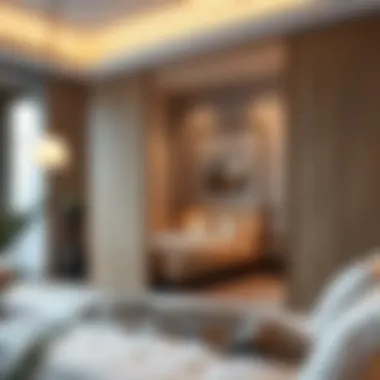
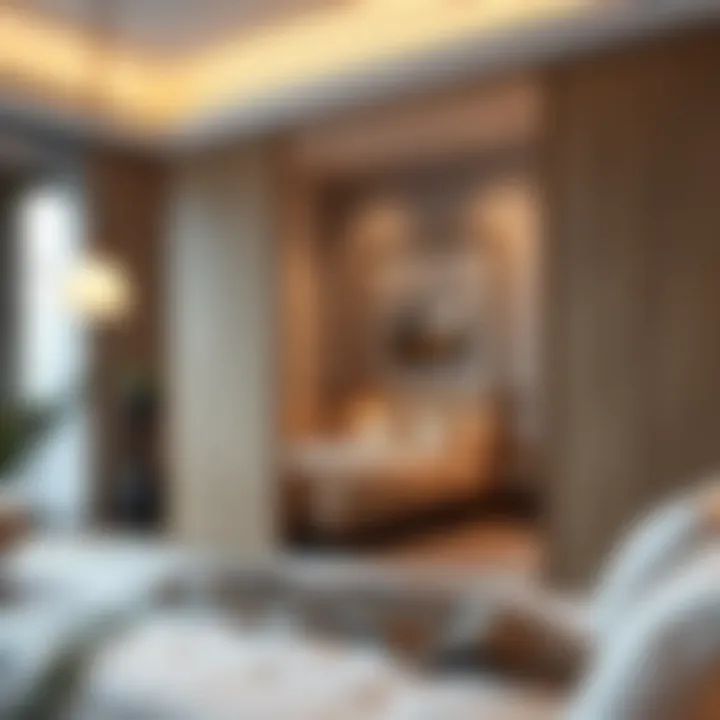
Advantages of foldable partitions include:
- Flexibility: Easily modify your space for various functions without a major overhaul, which passive setups do not provide.
- Space Saving: They require less area than fixed walls and can be pushed aside when not in use.
- Aesthetic Versatility: Depending on your choice of finish, they can seamlessly integrate with existing decor styles, thus there's no need to change the overall tone of your space.
In essence, while the upfront cost of foldable partitions may seem competitive, the long-term benefits of adaptability, functionality, and style may culminate in a stronger value proposition as compared to traditional partitions.
Maintenance and Care for Foldable Partitions
Maintaining and caring for foldable partitions is paramount for ensuring their longevity and functionality in your living or working space. These versatile structures are not just functional; they're aesthetic additions that can significantly enhance the ambiance of a room. However, regular upkeep is critical to preserving their performance and appearance over time. By adopting proper maintenance practices, homeowners can avoid premature wear and ensure that their foldable partitions remain a seamless part of their interior design.
Regular Cleaning Practices
Keeping foldable partitions clean is a simple yet effective way to maintain their value. Dust and grime accumulate unnoticed over time, so here are some straightforward cleaning practices to consider:
- Dust Regularly: Use a soft, lint-free cloth or microfiber duster to wipe down surfaces. This helps prevent buildup that can scratch or scuff the finish.
- Gentle Cleaning Solutions: For deeper cleaning, opt for a mild soap solution mixed with water. Avoid harsh chemicals that might harm the material. Just a few drops of dish soap in warm water will usually do the trick.
- Assess Material Specifics: Every type of partition requires different care based on materials. For example, a wood partition may need oiling every now and then to keep it from drying out, while glass or acrylic may require a streak-free cleaner to maintain clarity and shine.
- Check Mechanisms: As you clean, pay attention to the mechanical components. Dirt can accumulate around the tracks or hinges, leading to operational issues. A quick wipe with a damp cloth can prevent this.
"Proper maintenance isn't just about aesthetics; it's about preserving the function these versatile designs offer."
Long-term Care Recommendations
To ensure that foldable partitions function well and look great for years to come, long-term care strategies are essential. Beyond regular cleaning practices, consider these recommendations:
- Lubrication of Moving Parts: Every few months, apply a silicone-based lubricant to hinges and tracks to keep particles from sticking and to ensure smooth operation. This will help prevent frustrating jams or mechanical failures.
- Inspect for Damage: Periodically check for any dents, scratches, or damage caused by everyday use. Addressing issues early can prevent them from escalating. For example, minor scratches on a wood partition can often be concealed with touch-up markers or furniture polish.
- Seasonal Care: Depending on your climate, certain materials may behave differently. For instance, wood can expand in humid conditions. In such cases, seasonal checks can help maintain stability and prevent warping that can compromise structural integrity.
- Professional Maintenance: For high-end installations or complex systems, consider hiring a professional for annual maintenance checks. They can identify problems that might not be visible to the untrained eye and offer repairs that enhance lifespan.
By paying careful attention to these aspects of maintenance and care, homeowners can maximize the lifespan of their foldable partitions, ensuring they continue to serve their purpose while remaining beautiful highlights within modern interiors.
For more insights on home care, check out reputable sources such as Wikipedia or Britannica. Learn more about maintenance tips and tricks on Reddit.
The job of maintaining foldable partitions extends well beyond the basics. It requires a thoughtful approach that respects both the form and function of these dynamic elements.
Dealing with Common Issues
In the world of foldable partitions, just like any other fixture in home design, problems can and do arise. Understanding how to address these common issues not only saves time and money but also ensures that these partitions continue to function effectively, enhancing the overall aesthetics and utility of your space. The importance of tackling these challenges is underscored by the fact that foldable partitions are often used in dynamic environments where flexibility is key, such as in open floor plans or multifunctional rooms. The following sections will explore two prevalent issues: misaligned panels and stuck mechanisms.
Aligning Misaligned Panels
Misalignment can happen for a variety of reasons—be it the settling of the house, wear and tear over time, or a mishap during installation. An aligned panel is crucial for the smooth operation of your foldable partition. If panels don't align properly, it can lead to difficulties when opening or closing. This dysfunctional performance doesn’t just irritate users; it can actually diminish the aesthetic appeal of your space.
To realign those pesky panels, follow these straightforward steps:
- Inspect the Track: Start by checking the track of the partition. If there’s dirt or debris stuck in there, it might be pushing the panels off course. A quick wipe can often fix this.
- Adjust the Hinge Mechanism: Sometimes, the issue lies with the hinge. You may need to loosen the screws and gently adjust the position of the panel to get everything back on track.
- Using a Level: Lay a level tool against the panel to see just how off it might be. This will give you a better idea of how far you need to adjust.
While it might take a bit of patience to line things up just right, the satisfaction that comes from a perfectly functioning partition is worth the effort.
Fixing Stuck Mechanisms
There's nothing more frustrating than a partition that won’t budge, especially when you're in a hurry to reconfigure your space. Stuck mechanisms can usually be traced back to a few key issues: lack of lubrication, dirt accumulation, or a malfunctioning component. Whatever the cause, the fix is often simpler than you might think.
To tackle a stuck partition mechanism, you can follow these practical steps:
- Cleaning: Start by cleaning the area around the mechanism with a damp cloth. Removing accumulated dust or grime often does the trick.
- Lubrication: Apply a suitable lubricant to the moving parts of the mechanism. Silicone spray is usually a safe go-to as it doesn’t attract dust like some oil-based products.
- Inspecting Parts: Check if any components are damaged or worn out. If so, you may need to replace them to restore functionality.
Keeping the mechanisms well-maintained will not only enhance performance but also prolong the life of your partitions. Regular inspection can help prevent these issues before they escalate.
"A little maintenance goes a long way in ensuring your foldable partitions serve you well for years to come."
Whether you are a homeowner, designer, or a DIY enthusiast, being aware of these common issues with foldable partitions will equip you to handle them effectively. Proactive maintenance is key in keeping these versatile components functioning smoothly, allowing you to enjoy the benefits they bring to your living space.
Future Trends in Foldable Partitions
The landscape of interior design is always shifting, and foldable partitions are no exception. As we dive into future trends in foldable partitions, it’s essential to highlight their evolving nature and what that signifies for both homeowners and designers. These partitions aren't just practical solutions for space management; they’re also becoming pivotal in achieving styles that resonate with modern sensibilities. The growing awareness about sustainability and advancements in smart technology are two critical trends that will shape the future of foldable partitions.
Sustainability in Materials
As environmental awareness escalates, the sustainability of materials used in foldable partitions is becoming an indispensable consideration. Homeowners are increasingly seeking out products that are manufactured from recycled or eco-friendly sources. For example, bamboo is gaining traction as a sustainable option. Its rapid growth rate and natural aesthetic make it an attractive choice for partitions.
Moreover, companies are exploring bio-based plastics and sustainable wood options, which not only reduce carbon footprints but also add unique character to spaces. The use of recycled materials not only aligns with eco-conscious designs but also brings a sense of individuality to each installation.
Some key aspects to consider when choosing sustainable materials for foldable partitions include:
- Certifications: Look for products with certifications like FSC (Forest Stewardship Council) that ensure responsible sourcing.
- Durability: Opt for materials that withstand wear and tear, ensuring a long-lasting investment.
- Aesthetic appeal: Sustainable doesn’t have to mean unattractive—consider finishes and textures that enhance visual appeal while being kind to the planet.
"Choosing sustainable materials can significantly impact both your interior aesthetics and the environment. Every small choice counts."
Smart Technology Integration
The integration of smart technology into foldable partitions is not just a trend; it’s becoming a standard expectation in modern interior design. Home automation continues to rise, and foldable partitions are included in this wave of innovation. Imagine partitions that can be opened or closed with a simple voice command or a tap on a smartphone app.
This technological advancement promotes convenience and flexibility, allowing homeowners to reconfigure their spaces quickly without the hassle of manual adjustments. Smart mechanisms can also incorporate sensors that detect human presence, adjusting opening speeds or functionalities based on the room's usage, leading to energy savings and enhanced functionality.
Consider the following benefits of incorporating smart technology:
- Versatility: Easily transform an open layout into a cozy space for gatherings or work.
- Efficiency: Save time when adjusting the space, appealing to the fast-paced lifestyles of many.
- Enhanced Control: Monitor and control partitions from anywhere, providing unmatched flexibility.
As we gaze into the future, the combination of sustainability and smart technology will undoubtedly continue to revolutionize the role of foldable partitions in modern interiors, making them not just elements of design but essential features of functional living.
Proper integration of these trends into interior designs can set a home apart, reinforcing the marriage between style and practicality.
